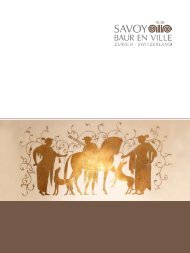Create successful ePaper yourself
Turn your PDF publications into a flip-book with our unique Google optimized e-Paper software.
ly designed a number of Japanese museums, including the Nagano Prefectural Museum, the Marugame Genichiro-<br />
Inokuma Museum of Contemporary Art, Tje Toyota Municipal Museum of Art and the Gallery of Horju-ji Treasures at<br />
the Tokyo National Museum. Other proud works include the Shiseido Museum of Art and the Tokyo National Museum’s<br />
Gallery of Horyuji Treasures. Yet it was his design for a less austere site – the Tokyo Sea Life Park – that drew the greatest<br />
accolades. Taniguchi’s buildings have a solid but cool minimalism to them. He prefers to let the wood or stone<br />
itself convey the building’s esthetic beauty. As he rightly says: «In my generation, a lot of architects give prominence<br />
to design. I manage to conceal details.» When he took part in the design competition for the Museum of Modern Art<br />
expansion project, he told the MoMA trustees in all earnest that, if they were to raise a lot of money for the project,<br />
he would deliver very good architecture. However, if they were to raise lots more money, he would make the archi-<br />
tecture disappear!<br />
Taniguchi then presented them a model that featured glass, aluminum and black slate. Fearing his presentation<br />
would be rejected, however, he made a rather hasty exit and, out of sheer frustration, headed for the nearest watering<br />
hole! His misgivings proved unfounded, however, and in late 1997 he became the architect of choice for the<br />
MoMA project, beating ten other internationally acclaimed architects – people of the caliber of the Netherlands’ Rem<br />
Koolhaas, Bernard Tschumi and Swiss architects Jacques Herzog and Pierre de Meuron. «Life presents surprises in<br />
various boxes and we have to wait graciously for them to be handed to us!» Taniguchi told me with a quiet chuckle.<br />
Some regard his style as overly corporate, ill-suited to a museum. For others, however, Taniguchi has created nothing<br />
short of architectural perfection! Take, for instance, the famous verdict by Alfred Barr, the museum’s founding director:<br />
«The museum is a torpedo moving through time which, as it rockets forward, leaves history in its wake.»<br />
My thanks go to you, Yoshio Taniguchi, for making this all possible!<br />
Thomas P. Campbell – Director and CEO<br />
of the Metropolitan Museum of Art<br />
In September 2008, the Metropolitan Museum of Art announced that Thomas<br />
P. Campbell, a highly accomplished curator from Oxford, England, whose specialty is<br />
European tapestry, had been elected its next director, succeeding the legendary Philippe<br />
de Montebello, who had led the museum for 31 years.<br />
Tom Campbell was born in Singapore and raised in Cambridge, England. He re-<br />
ceived his Bachelor of Arts degree in English language and literature from the University<br />
of Oxford in 1984, followed by a diploma from Christie’s Fine and Decorative Arts course,<br />
London, in 1985. While studying for his Master’s degree at the Courtauld Institute of Art<br />
(1987), he realized the extent to which mainstream art history had overlooked the major<br />
role tapestries have played in European art and propaganda. Thereupon, he spent seven<br />
years working hard to rectify this omission by creating the Franses Tapestry Archive in<br />
London, which, with more than 120,000 images, is the largest and most up-to-date information<br />
resource on European tapestries and figurative textiles in the world. His early<br />
research culminated in several ground-breaking articles and a Ph.D. from the Courtauld<br />
Institute (1999) on the art and culture of King Henry VIII’s court.<br />
Campbell has spent 14 years in the Metropolitan Museum’s Department of European<br />
Sculpture and Decorative Arts, rising through the ranks as Assistant Curator (1995-97),<br />
Associate Curator (1997-2003) and Curator (2003 to the present). During this time, he<br />
conceived and organized the major exhibitions Tapestry in the Renaissance: Art and<br />
Magnificence (2002) and Tapestry in the Baroque: Threads of Splendor (New York, 2007;<br />
Palacio Real, Madrid, spring 2008), both of which incorporated drawings, paintings and<br />
prints, as well as actual tapestries, and drew immense worldwide acclaim. The 2002<br />
exhibition was named «Exhibition of the Year» by Apollo magazine, and its catalogue<br />
won the Alfred H. Barr, Jr. Award (College Art Association) for distinguished exhibition<br />
catalogues in the history of art (2003). Campbell was also responsible for adding to the<br />
museum’s stock of European textiles, including the acquisition of extremely rare tapes-<br />
views magazine | 57



